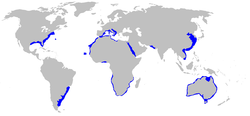bio.wikisort.org - Animalia
Lo squalo toro (Carcharias taurus (Rafinesque, 1810)), detto anche squalo tigre sabbia (in inglese sand tiger shark) è uno squalo appartenente alla famiglia degli odontaspididi e all'ordine dei lamniformi. Si tratta di un grosso predatore abitante delle acque costali di tutto il mondo con nomi diversi a seconda del luogo in cui abita. Nonostante il suo aspetto, è relativamente placido e si muove lentamente, benché sia un ottimo nuotatore. È a rischio d'estinzione.
| Squalo toro | |
|---|---|
 | |
| Stato di conservazione | |
 Critico[1] | |
| Classificazione scientifica | |
| Dominio | Eukaryota |
| Regno | Animalia |
| Sottoregno | Eumetazoa |
| Superphylum | Deuterostomia |
| Phylum | Chordata |
| Subphylum | Vertebrata |
| Infraphylum | Gnathostomata |
| Classe | Chondrichthyes |
| Sottoclasse | Elasmobranchii |
| Superordine | Selachimorpha |
| Ordine | Lamniformes |
| Famiglia | Odontaspididae |
| Genere | Carcharias |
| Specie | C. taurus |
| Nomenclatura binomiale | |
| Carcharias taurus Rafinesque, 1810 | |
| Areale | |
|
| |
Spesso, in italiano, viene confuso con il Carcharhinus leucas, a causa del nome inglese di quest'ultimo, bull shark.
Distribuzione
Lo squalo si raduna tipicamente nelle acque costiere, alla profondità di 10-60 metri, anche se è stato visto in profondità maggiori. Spesso si nasconde in buche e grotte durante il giorno ed esce la notte per mangiare. Ricerche indicano che generalmente lo squalo rimane entro un chilometro dal luogo di aggregazione e vicino al fondo dell'oceano. Al contrario di altri squali non ha bisogno di muoversi per respirare, vantaggio per essere furtivo nelle sue battute di caccia. È presente in tutto il mondo, nell'Atlantico, nel Pacifico e nell'Oceano Indiano. Tra il 1950 e il 1960 era vicino all'estinzione nelle acque australiane dove ancora oggi è classificato come vulnerabile.
Anatomia
Il corpo è massiccio, con due larghe pinne dorsali, la coda è allungata con un lungo lobo superiore. Cresce fino alla lunghezza di 320 cm. Il maschio raggiunge la maturità quando è grande 220 cm e la femmina a 210 cm.
Riproduzione
La riproduzione è ovovivipara. La femmina ha due uteri. Dentro ogni utero, l'embrione che si sviluppa per primo inizia a cibarsi dei fratelli non ancora sviluppati per sopravvivere. La madre inizia poi a produrre uova non fecondate, in modo che il piccolo possa nutrirsene. La gestazione dura dai 6 ai 9 mesi. Normalmente, la madre mette al mondo due cuccioli (un superstite per utero).
Note
- (EN) Pollard, D. & Smith, A., Carcharias taurus, su IUCN Red List of Threatened Species, Versione 2020.2, IUCN, 2020. URL consultato il 15 marzo 2020.
Bibliografia
- (EN) Pollard, D. & Smith, A. 2000, Carcharias taurus, su IUCN Red List of Threatened Species, Versione 2020.2, IUCN, 2020.
Altri progetti
 Wikimedia Commons contiene immagini o altri file su Carcharias taurus
Wikimedia Commons contiene immagini o altri file su Carcharias taurus Wikispecies contiene informazioni su Carcharias taurus
Wikispecies contiene informazioni su Carcharias taurus
Collegamenti esterni
- Immagini di Squalo Toro, su gol.grosseto.it. URL consultato il 14 gennaio 2006 (archiviato dall'url originale il 7 gennaio 2006).
- (EN) Compagno, L.J.V. (1984), Carcharias taurus, in WoRMS (World Register of Marine Species).
На других языках
[en] Sand tiger shark
The sand tiger shark (Carcharias taurus), gray nurse shark, spotted ragged-tooth shark or blue-nurse sand tiger, is a species of shark that inhabits subtropical and temperate waters worldwide. It inhabits the continental shelf, from sandy shorelines (hence the name sand tiger shark) and submerged reefs to a depth of around 191 m (627 ft).[2] They dwell in the waters of Japan, Australia, South Africa, and the east coasts of North and South America. The sand tiger shark also inhabited the Mediterranean, however it was last seen there in 2003 and is presumed extinct in the region. Despite its common names, it is not closely related to either the tiger shark (Galeocerdo cuvier) or the nurse shark (Ginglymostoma cirratum).[es] Carcharias taurus
El tiburón toro, enfermera gris (nombre FAO),[2] tiburón de leznas [3] tiburón tigre de arena o tiburón damisela[4] (Carcharias taurus), (que no debe ser confundido con el que se conoce en inglés como "Bull Shark" -Carcharhinus leucas-, que en español es conocido como tiburón sarda y con quien ni siquiera comparte orden taxonómico) es una especie de elasmobranquio lamniforme de la familia Odontaspididae presente en todo el mundo, océanos Atlántico, Índico y Pacífico. Es también conocido como tiburón dientes cerrados o en Argentina : escalandrún. Generalmente permanecen dentro del kilómetro de su sitio de agregación, y gusta de estar en el piso oceánico.[fr] Carcharias taurus
Requin-taureau- [it] Carcharias taurus
[ru] Обыкновенная песчаная акула
Обыкновенная песчаная акула[1], или серая песчаная акула, или атлантическая песчаная акула[2], или европейская песчаная акула[2], или аргентинская песчаная акула, или австралийская песчаная акула[2], или австралийская акула-нянька[3] (лат. Carcharias taurus) — хрящевая рыба больших размеров, встречающаяся в тёплых прибрежных водах субтропиков. Эта акула обладает следующими особенностями: голова уплощённо-конической формы, длинный рот начинается перед глазами, третье веко отсутствует, зубы длинные и узкие с хорошо заметными бугорками, анальные и спинные плавники примерно одинакового размера, хвостовой плавник асимметричный с выдающейся верхней лопастью, цвет — светло-коричневый, зачастую с тёмными рыжеватыми или коричневыми точками. Обыкновенные песчаные акулы иногда охотятся, сбившись в стаи. Их рацион состоит из костистых рыб, кальмаров и скатов. В отличие от других акул они способны заглатывать с поверхности воды воздух, придавая себе нейтральную плавучесть, и зависать в толще воды с минимальными усилиями. Эти акулы легко уживаются в неволе.Другой контент может иметь иную лицензию. Перед использованием материалов сайта WikiSort.org внимательно изучите правила лицензирования конкретных элементов наполнения сайта.
WikiSort.org - проект по пересортировке и дополнению контента Википедии

